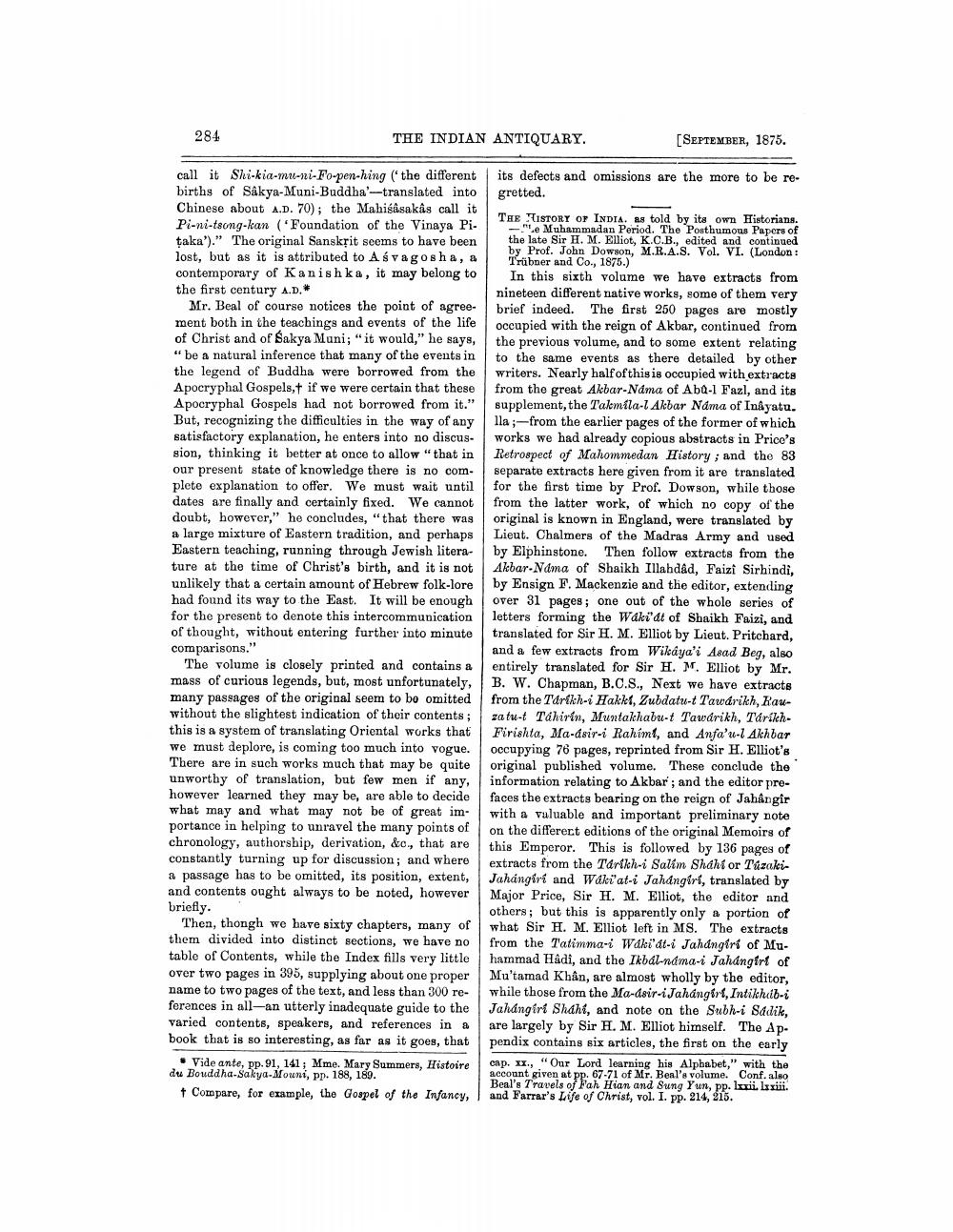________________
284
THE INDIAN ANTIQUARY.
[SEPTEMBER, 1875.
call it Sli-kia-mu-ni-Fo-pen-hing the different its defects and omissions are the more to be rebirths of Såkya-Muni-Buddha'-translated into gretted. Chinese about A.D. 70); the Mahiśâsakâs call it
THE HISTORY OF INDIA. as told by its own Historians. Pi-ni-tsong-kan ('Foundation of the Vinaya Pi. -". Muhammadan Period. The Posthumous Papers of taka")." The original Sanskrit seems to have been
the late Sir H. M. Elliot, K.C.B., edited and continued
by Prof. John Dowson, M.R.A.S. Vol. VI. (London: lost, but as it is attributed to As vagosha, a
Trübner and Co., 1875.) contemporary of Kanishka, it may belong to In this sixth volume we have extracts from the first century A.D.*
nineteen different native works, some of them very Mr. Beal of course notices the point of agree brief indeed. The first 250 pages are mostly ment both in the teachings and events of the life occupied with the reign of Akbar, continued from of Christ and of Bakya Muni; "it would," he says, the previous volume, and to some extent relating "be a natural inference that many of the events in to the same events as there detailed by other the legend of Buddha were borrowed from the writers. Nearly half of this is occupied with extracts Apocryphal Gospels,t if we were certain that these from the great Akbar-Nama of AbQ.1 Fazl, and its Apocryphal Gospels had not borrowed from it." supplement, the Talmíla-l Akbar Nama of Infyatu. But, recognizing the difficulties in the way of any lla;- from the earlier pages of the former of which satisfactory explanation, he enters into no discus- works we had already copious abstracts in Price's sion, thinking it better at once to allow " that in Retrospect of Mahommedan History; and the 83 our present state of knowledge there is no com- separate extracts here given from it are translated plete explanation to offer. We must wait until for the first time by Prof. Dowson, while those dates are finally and certainly fixed. We cannot from the latter work, of which no copy of the doubt, however," he concludes, "that there was original is known in England, were translated by a large mixture of Eastern tradition, and perhaps | Lieut. Chalmers of the Madras Army and used Eastern teaching, running through Jewish litera- by Elphinstone. Then follow extracts from the ture at the time of Christ's birth, and it is not Akbar-Nama of Shaikh Illahdad, Faizi Sirhindi, unlikely that a certain amount of Hebrew folk-lore by Ensign F. Mackenzie and the editor, extending had found its way to the East. It will be enough over 31 pages; one out of the whole series of for the present to denote this intercommunication letters forming the Waki'dt of Shaikh Faizi, and of thought, without entering further into minute translated for Sir H. M. Elliot by Lieut. Pritchard, comparisons."
and a few extracts from Wikaya'i Asad Beg, also The volume is closely printed and contains a entirely translated for Sir H. M. Elliot by Mr. mass of curious legends, but, most unfortunately, B. W. Chapman, B.C.S., Next we have extracts many passages of the original seem to bo omitted from the Tarikh-i Hakkt, Zubdatu-t Tawdrikh, Rauwithout the slightest indication of their contents; zatut Tahirin, Muntakhabu-t Tawdrikh, Tarikhthis is a system of translating Oriental works that Firishta, Ma-dsir-i Rahimt, and Anfa'u-l Akhbar we must deplore, is coming too much into vogue. occupying 76 pages, reprinted from Sir H. Elliot's There are in such works much that may be quite original published volume. These conclude the unworthy of translation, but few men if any, information relating to Akbar'; and the editor prehowever learned they may be, are able to decide faces the extracts bearing on the reign of Jahangir what may and what may not be of great im- with a valuable and important preliminary note portance in helping to unravel the many points of on the differert editions of the original Memoirs of chronology, authorship, derivation, &c., that are this Emperor. This is followed by 136 pages of constantly turning up for discussion; and where extracts from the Tarikh-i Salim Shahi or Tázakia passage has to be omitted, its position, extent, Jahangiri and Waki'at-i Jahangiri, translated by and contents ought always to be noted, however Major Price, Sir H. M. Elliot, the editor and briefly.
others; but this is apparently only a portion of Then, thongh we have sixty chapters, many of what Sir H. M. Elliot left in MS. The extracts them divided into distinct sections, we have no from the Tatimma-i Waki'dt-i Jahangiri of Mutable of Contents, while the Index fills very little hammad Hadi, and the Ikbál-nama-i Jahangfrt of over two pages in 395, supplying about one proper Mu'tamad Khan, are almost wholly by the editor, name to two pages of the text, and less than 300 re- while those from the Ma-dsir-iJahangert, Intikhuib-i ferences in all-an utterly inadequate guide to the Jahangiri Shahi, and note on the Subh-i Sadik, varied contents, speakers, and references in a are largely by Sir H. M. Elliot himself. The Apbook that is so interesting, as far as it goes, that pendix contains six articles, the first on the early • Vide ante, pp. 91, 141 : Mme. Mary Summers, Histoire
cap. 1.,"Our Lord learning his Alphabet," with the du Bouddha-Sakya Mouni, pp. 188, 189.
account given at pp. 67-71 of Mr. Beal'a volume. Conf. also
Beal's Travels of Fah Hian and Sung Yun, pp. lxxii. Laxii. Compare, for example, the Gospel of the Infancy, and Farrar's Life of Christ, vol. I. pp. 214, 215.




